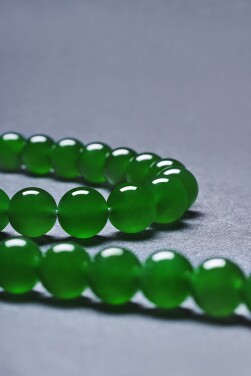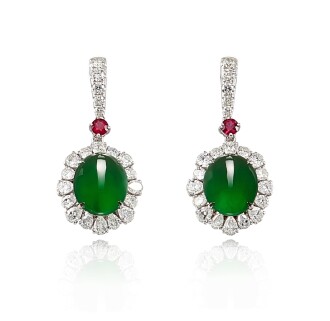For hundreds of years, jadeite has been a symbol of supreme status and extreme wealth. Yet within this world of jewels and superlatives, jadeite has a certain understated charisma.
When light passes through the stone, the effect is a muted, enigmatic glow that is both indescribable and can fill volumes. This allure has inspired mythologies and a cultural reverence, particularly in China, that stretches back centuries.
By virtue of its unique features, jade has played a consequential role in history – from serving as a mysterious object of ritual to adorning the leaders of powerful empires. While term “jade” is frequently used interchangeably to describe both nephrite and jadeite, both are highly prized for different traditions. A gemstone of unsurpassed beauty that at its finest may possess an inimitable green color, jadeite is by far the rarer of the two and the focus of this guide on jewelry. We asked Wenhao Yu, Sotheby’s Hong Kong Deputy Chairman of Jewelry, Asia, to share his expertise on understanding and collecting jadeite.
Jadeite as a Work of Art
When it comes to assessing fine quality jadeite jewelry, there is no easy formula. While there are scales to describe desirable attributes of the stone – i.e., translucence, clarity, cut, color, saturation, hue, etc. – the sum of these metrics can not nearly capture the varied, complicated factors that contribute to a particular jadeite’s beauty.
“Approach jadeite jewelry not as a commodity, but rather as a work of art created by nature and shaped by human hands.”
What experts look for in an ideal stone is a certain “wow” factor, which may seem frustratingly imprecise for would-be collectors seeking more concrete guidance. However, all of this makes sense when we approach jadeite jewelry not as commodities, but rather as works of art created by nature and shaped by human hands. Just as it's impossible to measure the splendor of Impressionist landscapes by the canvas's height and width or the ratio of its colors, the beauty of jadeite, in all its variety and complexity, cannot be classified by a system of prescribed standards.
Light Refracted Through Water
The aesthetics of jadeite is different from those of other gemstones. In other words, jadeite doesn’t sparkle, it glows. Unlike diamonds or emeralds, which possess highly reflective transparent crystalline, jadeite is a mineral with a more complex chemical composition. This is the reason why, as a rule, jadeite is polished without facets. Cabochon and other smooth, rounded shapes best display the almost aqueous quality of jadeite.
“Jadeite appears to contain water with just a single drop of milk or ink mixed within. The translucent stone diffuses light, which turns around in the jadeite so that the gemstone appears to be glowing from inside. “
To appreciate jadeite is to understand the cultures of China and much of Asia, according to Yu. Top-quality jadeites possess a dense structure, fine crystals, even color, high translucency and a depth that evokes a sense of tranquility. That soft radiance is one of the reasons why jadeite remains the most sought-after gemstone in China, by far. Compared with jewels that dazzle and sparkle with brilliant fire, jadeite possesses a cool, watery luminosity suited for those who value a more understated aesthetic.
A Range of Colors
Hue and saturation are important factors in understanding the stone. The term for jadeite, “fei cui,” refers to kingfisher’s brightly colored plumage: the male fei boasts rich autumnal red coloring, whereas the female green bird is named cui. Traditionally, both colors are associated with jadeite and highly valued. Jadeite can be found in a variety of colors ranging from greens, mauve, lavender, yellow, white, black and even colorless. For a brief period years ago, black jadeite had enjoyed great popularity with collectors, a market that could not be sustained owing to the rarity of the color. However, green is by far the most sought-after color for jadeite jewelry, notably Imperial Green.
Imperial Green
“Imperial Green” refers to jadeite that is richly saturated with a deep medium tone, slightly more yellow than a fine emerald green without any off-tones such as brown or gray, and no inclusions. The best examples should be highly saturated, slightly unctuous and penetrating, showing intensely even when viewed from a distance. The tone is neither too light nor too dark, and the color is evenly distributed without showing veins, clouding, mottling or blotches.
The designation of “Imperial Green” can be considered a parallel to the international color standards set for other gemstones – i.e.,“Pigeon's Blood” for rubies and “Royal Blue” for sapphires. Switzerland’s leading laboratories for colored stone testing, Gübelin Gem Lab and Swiss Gemmological Institute SSEF, appear to be moving in the direction to establish the Imperial Green standard as international interest in fine jadeite continues to grow. However, it remains early in the process as the labs develop their grading systems with jadeite. Currently, official grading guidelines have yet to be published. Such things take time, and the process requires that the labs have enough samples for comparison.
While it is undoubtedly a benefit to have Gübelin and SSEF provide third-party confirmation of Sotheby’s high standards at auction, the actual process may be time consuming and costly. Sotheby’s experts will usually already have a high level of confidence a piece will receive “Imperial Green” designation before submitting it to the Swiss labs for consideration. However, Sotheby’s may not submit certain top-quality jadeite pieces for different reasons. For example, as a general rule Sotheby’s will not submit carved jadeite for consideration for the standard. This is because it’s possible for a skilled carver to avoid or take away any natural imperfections or inclusions from the rough, which creates an unequal comparison with a sample that might be in a more regular shape. Yet the lack of the “Imperial Green” designation does not mean lesser quality, as the carved jadeite may still possess the same desirable lustrous green hue.
It is also important to keep in mind that top quality rare jadeite has a wide range. Sometimes the “best” kind of green is governed be personal taste, as many experienced collectors do prefer slightly more yellowish hue than Imperial Green, while others are drawn entirely to lavender (because there aren’t many lavender color stones in general).
“If Zao Wou-Ki was considered to have reached his creative peak in the 1970s, collectors certainly wouldn’t value only his paintings from just that decade to the exclusion of everything else he created before or after. Similarly, you can’t just buy only Imperial Green jadeite. It can become quite boring if a collector decided to take such narrow focus.”
Bangles, Beads and Cabochon
The properties of jadeite are shown to greatest effect when cut into smooth and rounded shapes. The approach to cutting jadeite differs from the art of cutting diamonds, which perhaps might be chalked up to history and culture. Understanding the process of how a piece is crafted from rough boulder will enhance the collectors’ appreciation of fine jadeite jewelry. This process is best understood when in context of three classic shapes: the bangle, beads, and cabochon.
The coveted green in jadeite runs as a rare vein through host boulder, which is considered precious even as it is often intersected by the mottling of inclusions and colorless zones. The only way to assess the quality of the vein is to cut open the rough boulder. Similar to graining in wood, the texture of the stone appears different when viewed along the length of the shun wen (even grain) versus the ni wen (end grain). Hence, the angle will change the appearance of this stone, meaning visual inconsistency would normally be expected.
To fashion forms such as a bangle involves immense wastage, and as the cutting of a bangle requires a large surface area of the precious green vein, it is most common to find bangle forms with varying textures, opacities and colors. For an Imperial Green bangle, imagine the amount of skill and luck involved. First, one would have to find a boulder, a marvel of nature, large enough to accommodate a large hololith, and then, much of the precious material must be expended in the process. It is the highest achievement to transform any top quality stone into a large single piece of uniform translucency, perfect distribution of hue and saturation, and showing no clouding or mottling.
For the same reason, jadeite bead necklaces are also highly coveted and luxurious. Ideally, each bead will match uniformly in color and texture, and this effect can only be achieved by carving from the same rough. Over half of a material’s rough can be lost in the attempt to cut out a presentable sphere. Color and texture are the most important factors for matching jadeite beads. Craftsmen also match transparency, size, and symmetry of cut. Because of the extraordinary difficulties in matching, especially for color, longer strands or larger beads can command extremely high prices.
The classic cut for jadeite is the cabochon; the smooth domed shape is a perfect celebration of the material. The intricate beauty of jadeite is best seen in their mere simplicity, the finest jadeites are always polished as a cabochon spared of superfluous embellishments. Beyond these three standard shapes, jadeite jewelry can take many forms, and the variety is part of the delight in collecting the majestic gemstone. The proportion, shape and polish of jadeite call for the highest level of craftsmanship in the world— possessed of supreme artistry, keen judgment and meticulous precision.
Growth of the Fine Jadeite Market
In Sotheby’s Hong Kong 2020 spring auctions, the sale of a remarkable jadeite bead necklace, the largest to receive a special Gubelin certificate for its Imperial Green quality, went under the hammer for a stunning HK$80.7 million (US$10.4 million) and after a bidding war between five determine phone bidders. This is evidence of renewed international interest in fine jadeite, with collectors from not only Asia but all over the world. Of course, jadeite has always been in fashion in Asia, however in recent years thar appreciation has surpassed cultural boundaries.
Throughout history, jadeites have been highly prized for its timeless beauty and worn by the rich and famous, many of whom were legendary female figures from the ruling class and notable fashion icons of all times.
In the early 20th century, Cartier and other jewelers from the West were inspired by Chinese culture and began to incorporate nephrite and jadeite in their designs for snuff boxes or vanity boxes. In the 1930s Cartier sourced 27 magnificent jadeite of highly translucent bright emerald green color, and with a clasp set with calibré-cut rubies and diamonds, created a legendary jadeite necklace for the heiress Barbara Hutton, given as wedding gift from her father. In 2014, Sotheby's had the privilege of selling the Hutton-Mdivani necklace, which achieved $27.4 million and stands as the auction record for any piece of jadeite jewelry and for a piece of Cartier jewelry.

Although jadeite has obvious associations with Asia its cultures, the success of jadeite jewelry at auction the gemstone’s broad appeal. Seasons upon seasons of auction show clear evidence that the appetite for collecting jadeite has only continued to grow. From the perspective of an auction house, certain trends within the fine jadeite jewelry market has become discernible, with enough data that Sotheby’s experts would be able to create an index of sorts.





















































